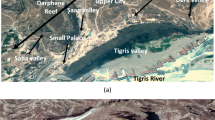Abstract
Siwa oasis is located in the extreme western part of the Egyptian western desert. There are several archaeological sites in the oasis; the most distinct ones are Alexander the Great temple at Aghormi hill and the Gebel El Mota tomb excavations. They have suffered due to deterioration and cracks of different kinds and some parts are getting worse as rock falls occur. From field inspection and lab analysis, it is clear that lithology plays an important role on the extent of damage. Alexander the Great temple was built over the northern edge of Aghormi hill, which consists of two distinct beds—an upper limestone bed and a lower shale one. From field survey and laboratory analysis, the shale is considered as a high expanded bed and weak in its bearing capacity, as its clay content (mainly smectite) experienced swelling due to wetting from the ground water spring underneath. Consequently, the upper limestone bed suffered from map cracking associated with rock falls due to the differential settlement of the swelled lower shale one. The temple was threatened by slope instability and had experienced many cracks. At Gabal El Mota tomb excavations, it was noticed that a comparison of tombs of the same opening size revealed that those that excavated on shale beds had cracked much more than those that excavated on limestone. This may be attributed to the low bearing capacity of excavated shale walls. The remedial measures suggested to overcome the stability problems on these archaeological sites are grouting or construction of retaining walls.














Similar content being viewed by others
References
Dunham RJ (1962) Classification of carbonate rocks according to depositional texture. In: Ham WE (ed) Classification of carbonate rocks. Memoirs of the American Association of Petroleum Geologist 1. Tulsa, OK, pp 108–121
El Khoriby EM, Issa GHI (1998) Sedimentology and mineralogy of recent continental Sabkha, Siwa depression, Western Desert, Egypt. Egypt J Geol V 42(2):621–640
Folk RT (1959) Practical petrographic classification of limestones. AAPG Bull V 43:1–38
Gindy AR, El Askary MA (1969) Stratigraphy, structure and origin of Siwa Depression, Western Desert, Egypt. AAPG Bull V 53:603–625
Holmes A (1965) Principles of physical geology. Ronald Press, New York, p 1288
Misak RF, Abdel Baki AA, Al Hakeem MS (1988) Ground water resources of Siwa oasis and the best way for exploitation. The first conference on environmental researches and studies. Ain Shams Univ (Abstract)
New Egyptian Code (1990) Evaluation of natural building stone
Said R (1960) New light on the origin of the Qattara Depression. Bull Soc Geograph Egypt V 33:37–44
Said R (1962) The geology of Egypt. Elsevier, Amsterdam, p 377
Tucker ME, Paul WV (1990) Carbonate sedimentology. Blackwell Scientific, Oxford
Author information
Authors and Affiliations
Corresponding author
Rights and permissions
About this article
Cite this article
Ibrahim, H.A.M., Kamh, G.E. Geoenvironmental studies on conservation of archaeological sites at Siwa oasis, Egypt. Environ Geol 49, 511–519 (2006). https://doi.org/10.1007/s00254-005-0051-x
Received:
Accepted:
Published:
Issue Date:
DOI: https://doi.org/10.1007/s00254-005-0051-x




